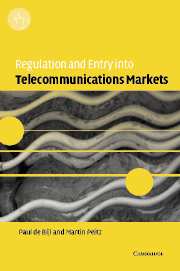Book contents
- Frontmatter
- Contents
- List of figures
- List of tables
- Preface
- Frequently used symbols
- License agreement and warranty disclaimer
- 1 Introduction
- 2 Telecommunications
- 3 The basic model
- 4 Facilities-based entry in a non-segmented market
- 5 Non-facilities-based entry in a non-segmented market
- 6 Entry in a non-segmented market: alternative pricing strategies
- 7 Non-targeted entry in a segmented market
- 8 Targeted entry
- 9 Concluding remarks
- Appendix: sample simulation program
- Bibliography
- Index
6 - Entry in a non-segmented market: alternative pricing strategies
Published online by Cambridge University Press: 22 September 2009
- Frontmatter
- Contents
- List of figures
- List of tables
- Preface
- Frequently used symbols
- License agreement and warranty disclaimer
- 1 Introduction
- 2 Telecommunications
- 3 The basic model
- 4 Facilities-based entry in a non-segmented market
- 5 Non-facilities-based entry in a non-segmented market
- 6 Entry in a non-segmented market: alternative pricing strategies
- 7 Non-targeted entry in a segmented market
- 8 Targeted entry
- 9 Concluding remarks
- Appendix: sample simulation program
- Bibliography
- Index
Summary
Introduction
This chapter explores alternative pricing strategies. In particular, we consider linear prices (operators do not charge subscription fees), flat fees (operators do not charge per-minute prices), and termination-based price discrimination (operators charge different per-minute prices for on-net and off-net calls).
Under competition in linear prices, operators can only make profits from traffic-dependent consumer expenditures, so linear pricing is more distortionary than two-part tariffs. The reason is that, with two-part tariffs, per-minute prices in equilibrium are set equal to perceived marginal costs, while this is not the case with linear prices.
Under two-part tariffs, operators exercise market power fully through subscription fees. When they cannot do this, they will set their per-minute prices above perceived marginal costs. In the extreme case, they can exercise their market power only through per-minute prices. Therefore, the analysis of linear pricing is an important complement to our analysis of two-part tariffs.
We focus our analysis of linear pricing on reciprocal and asymmetric access price regulation. In particular, we show that, in an infant market, asymmetric access price regulation is superior to cost-based access price regulation in terms of the entrant's profits, consumers surplus, and welfare. We also analyze the competitive effects of lease price regulation under local loop unbundling.
If operators compete on flat rates, then traffic-dependent costs have to be recovered solely from subscription fees.
- Type
- Chapter
- Information
- Regulation and Entry into Telecommunications Markets , pp. 142 - 184Publisher: Cambridge University PressPrint publication year: 2003



